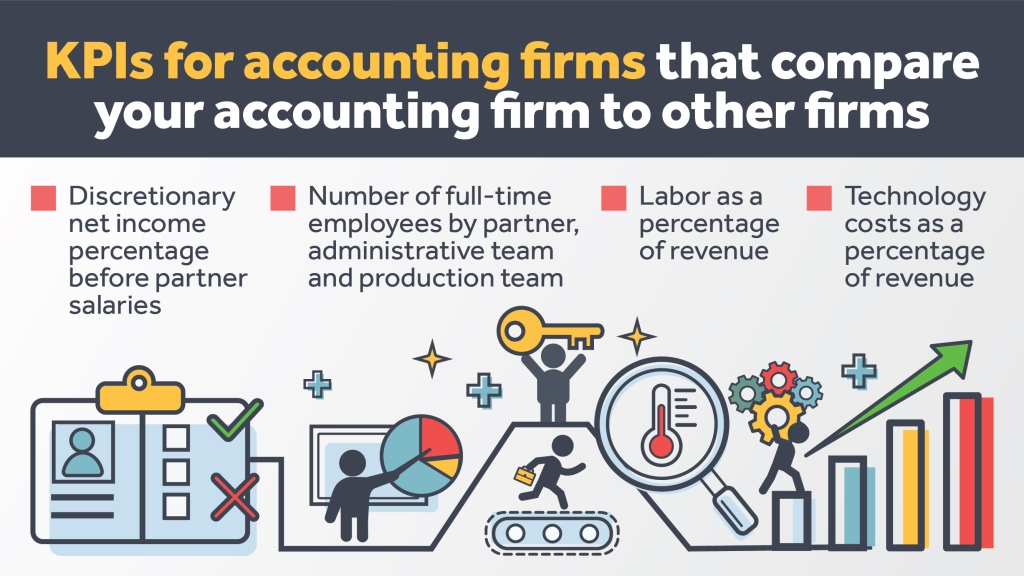Accountants work with numbers for a living. No one in the profession doubts the importance of tracking key performance indicators (KPIs). Some KPIs for accounting firms, such as revenue and profit, provide an obvious measure of how your firm is doing at a given time. But how are you tracking those numbers? And are there important metrics you might be missing?
The 10 KPIs every firm should track fit into three basic categories: comparing your firm’s current performance to past performance, comparing your firm to other firms and looking at the status of your leadership. While you’re likely tracking some of these numbers already, you might not be tracking them in the most useful way possible.
KPIs for accounting firms that compare your accounting firm to itself
The first four KPIs for accounting firms let you evaluate growth.
Rolling revenue for the prior 12 months
Here a theme emerges: Prioritize a rolling one-year period over simply looking at one calendar year versus another. Firms need to diversify revenues to rely less on tax season and drive business year-round. As such, looking at the last 12 months de-emphasizes the often-oversized impact tax season has on revenues.
Becoming a year-round firm is a key element of Smart Client Management, which helps firms rely less on tax season for revenue and at the same time lets them lighten the burden on employees, more effectively recruit staff and attain a more sustainable financial position. You want your 12-month rolling revenue to even out as much as possible and not be too weighted to the first four months of the year.
How to calculate it: Run a cash basis financial statement in your accounting system for the previous 12 months after the previous month has been reconciled, and enter total collections.
Rolling revenue for the prior 13 to 24 months
The same principle of Smart Client Management applies here. This metric gives you a comparative view of current revenue and lets you know how much you’ve improved over the prior 12-month period.
How to calculate it: Run a cash basis financial statement in your accounting system for the previous 13 to 24 months after the previous month has been reconciled, and enter total collections.
Monthly recurring revenue in the prior month
This view shortens the scope of time to offer some perspective on where monthly recurring revenue is as you focus on building a more consistent cash flow in your firm. Again, the idea here is not to let January through April or early fall timeframes drive the consistent financial sustainability of your firm. Can you offer clients monthly payment options to spread your cash flow evenly throughout the year?
How to calculate it: Look at the previous monthly back office support system (BOSS, for Rootworks members) revenue or all-inclusive fees collected for monthly recurring business clients.
Number of monthly recurring revenue clients
Your firm should seek to sign clients that will drive monthly recurring revenue, and, again, not just rely on the peak of cash flow that could occur during tax season. Clients that use only your tax services might not be worth keeping if all they’re doing is causing your employees to burn out during busy season. A better kind of client to sign is one that will pay you for services year-round and with whom you can maintain a deeper relationship.
How to calculate it: It’s a simple count of clients that drive recurring revenue as opposed to those that don’t.
KPIs for accounting firms that compare your accounting firm to other firms

Obviously, you won’t have the numbers from other firms, but you can put these KPIs for accounting firms up against benchmarks to see how you’re doing by comparison.
Discretionary net income percentage before partner salaries
This metric provides a look at how profitable your firm is before you pay yourself as a partner. You can use this number to determine how to compensate yourself and other partners based on similar metrics from the profession as a whole.
This metric can also help you determine the value of your firm and proceeds that would be received in an equity or succession event.
How to calculate it: Run a cash basis financial statement in your accounting system for the previous 12 months after the previous month has been reconciled. Add back discretionary expenses and partner compensation to arrive at adjusted net income and divide that amount by total collections.
Number of full-time employees by partner, administrative team and production team
This number plays into your overall labor strategy. Do you have enough employees in different roles for a firm your current size—or the size of the firm you want to build? Should you have more or fewer partners compared to administrative or production employees? You can compare staff to partner ratio, for instance, with metrics from other firms.
How to calculate it: This is a simple head count by partner, administrative team and production team. It is best to calculate based on full-time employee (FTE) equivalents.
Labor as a percentage of revenue
This is a critical metric in a profession rife with staffing shortages. The traditional benchmark has long been one-third of revenue percentage for labor, one-third for overhead and the final third for profit. That is changing. Labor costs can now account for 40% or more of revenue.
That’s not necessarily a bad thing. If your firm has a low percentage of labor to revenue, you as the firm owner are likely very involved—probably too involved—in production. That’s not a healthy situation for the firm as a whole and could cause a problem with succession plans.
If this number gets to greater than 50% and the firm owner is still working 2,400 hours per year in production, that’s getting thin on margin. However, with a less involved owner, labor of 40%-50% as a percentage of revenue could be acceptable. Keep in mind that the number for labor should consider all non-owner compensation, including benefits.
This number could also help determine whether you should outsource some functions and which ones you might consider moving out of your firm.
How to calculate it: Run a cash basis financial statement in your accounting system for the previous 12 months after the previous month has been reconciled. Divide labor costs by total collections. Labor costs are non-owner payroll, payroll taxes, employee benefits and contract labor.
Technology costs as a percentage of revenue
Before technology became a competitive differentiator for many firms, the benchmark here was just 4%. Now, it’s 10% for firms that want to develop a modern technology infrastructure. Some firms might justify going as high as 12% or more. Overinvesting in any one area is dangerous, but technology generally lowers costs and increases efficiency.
How to calculate it: Run a cash basis financial statement in your accounting system for the previous 12 months after the prior month has been reconciled. Divide total technology costs by total collections. Technology costs should include hardware, maintenance, hosting, service and software. Software should include any payroll service and client-provided software that isn’t paid for directly by clients.
KPIs for accounting firms that help you look at your leadership
At some point, you won’t run your firm anymore. You’ll either pass it on or sell it. A potential suitor will want to buy your business, not your job. If you’re spending too much time in production as a firm owner, you could struggle with succession. You need to look at these KPIs for accounting firms and firm leadership:
Average annual billable and non-billable partner hours
A good number of hours worked is simply fewer than you and your fellow partners worked last year. If you’re working 2,400 billable hours per year, you’ll likely have a hard time finding a premium buyer for your business when it comes time to sell. Show that you are bringing this metric down steadily, and you’ll make succession planning easier.
How to calculate it: It’s a simple count of billable and non-billable hours worked, by partner, if applicable.
Percentage of revenue by service line
Here, you can assess whether your firm should exit certain service offerings and invest more into advisory services. If you’re relying heavily on seasonal tax work or attest services, you need to consider finding new clients you can serve in other ways or moving existing clients toward advisory services.
How to calculate it: This is a simple division of revenue by the type of service that drives it.
Rethinking KPIs for accounting firms drives firm improvement
Looking at new numbers, or looking at old KPIs for accounting firms in a new way, gives you the insight you need to determine the financial stability of your firm. It also reveals whether you need to recalibrate your service offerings. When you put these numbers into action, you can increase revenue, improve employee morale and put yourself in a position to secure the future of your firm.
How are you running the applications you use to track KPIs? They work better in the cloud.
Catch Marcus Dillion’s presentation on key performance indicators for accounting firms at the Rootworks Empower conference.


